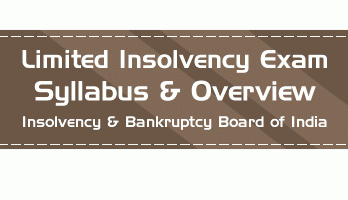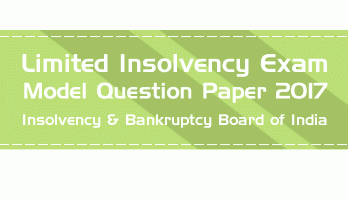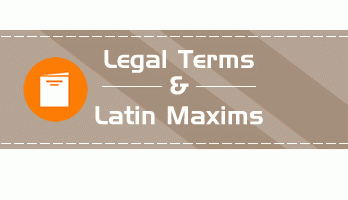This is a full-length model question paper for the Limited Insolvency Exam conducted by the Insolvency and Bankruptcy Board of India ( IBBI ). This is based on the H1 2017 syllabus which has been superseded. However, the paper is still relevant and is valuable for exam preparation and practice. Refer to this article for the 2018 syllabus and the model paper based on the 2018 syllabus is available here.
The syllabus for this exam is revised every six months, to include the latest Judicial decisions and also the recent updates in the Insolvency Laws.
Refer to the IBBI website for the syllabus for the latest exam.
1. Core services of an information utility do not include
(a) accepting electronic submission of financial information.
(b) safe and accurate recording of financial information.
(c) authenticating and verifying the financial information.
(d) determination of default.
Ans. (d)
2. A corporate insolvency resolution process commences on the date of .
(a) first meeting of the committee of creditors
(b) date of admission of the application by the National Company Law Tribunal
(c) date of appointment of interim resolution professional.
(d) date of public announcement.
Ans. (b)
3. A public announcement of the corporate insolvency resolution process may not contain
(a) penalties for false or misleading claims.
(b) details of the interim resolution professional.
(c) name of the authority with which the corporate debtor is incorporated.
(d) details of the assets and liabilities of the debtor.
Ans. (d)
4. The management of the affairs of a corporate debtor undergoing corporate insolvency resolution process vests in the
(a) Interim Resolution Professional.
(b) Board of Directors.
(c) Committee of Creditors.
(d) Insolvency and Bankruptcy Board of India.
Ans. (a)
5. A resolution professional does not require approval of the committee of creditors for
(a) creating security interest over the assets of the corporate debtor.
(b) undertaking related party transaction.
(c) amending constitutional document of the corporate debtor.
(d) issuing information memorandum.
Ans. (d)
6. A resolution professional shall file an application to the adjudicating authority to extend the period of fast track resolution if instructed to do so by a resolution passed at a meeting of the committee of creditors by a vote of not less than percent of the voting shares.
(a) 90
(b) 75
(c) 66
(d) 51
Ans. (b)
7. The liquidation estate of a corporate debtor comprises liquidation estate assets which include
(a) assets owned by a third party which are in possession of the corporate debtor.
(b) assets owned of an Indian subsidiary of the corporate debtor.
(c) assets of a foreign subsidiary of the corporate debtor.
(d) assets of the corporate debtor in respect of which a secured creditor has relinquished security interest.
Ans. (d)
8. A liquidator collects the claims of creditors on commencement of the liquidation process. Which of the following is true in this regard?
(a) A creditor may withdraw but not vary his claim.
(b) A creditor may not withdraw but vary his claim.
(c) A creditor may withdraw or vary his claim.
(d) A creditor may neither withdraw nor vary his claim.
Ans. (c)
9. A preference shall be deemed to be given at a relevant time under section 43 of the Insolvency and Bankruptcy Code, 2016 if it is given to a during the period of years preceding the insolvency commencement date.
(a) related party, two years
(b) unrelated party, two years
(c) related party, three years
(d) unrelated party, two years
Ans. (a)
10. The expression “workmen’s dues” for the purpose of distribution of proceeds from the sale of liquidation assets under section 53 of the Insolvency and Bankruptcy Code, 2016 shall have the same meaning as assigned to it in the
(a) the Companies Act, 2013.
(b) the Securitisation and Reconstruction of the Financial Assets and Enforcement of the Securities Interest Act, 2002.
(c) the Recovery of Debts Due to Banks and Financial Institutions Act, 1993.
(d) the Factories Act, 1948.
Ans. (a)
11. A debtor may apply for a Fresh Start Process, if his gross annual income does not exceed rupees .
(a) sixty thousand
(b) one lakh
(c) five lakh
(d) ten lakh
Ans. (a)
12. The debtor is discharged from interest by the Adjudicating Authority in respect of the qualifying debts under the Fresh Start Process from
(a) date of admission of application till the date of discharge order.
(b) date of application till the end of the moratorium period.
(c) date of application till the date of the discharge order.
(d) date of admission of application till the end of the moratorium period.
Ans. (c)
13. If an application is made for Insolvency Resolution Process by a partnership firm, an interim-moratorium shall commence on the date of the
(a) application in relation to qualifying debts and shall cease to have effect on the date of admission of such application.
(b) admission of application in relation to all the debts and shall cease to have effect within 7 days of admission of such application.
(c) application in relation to all the debts and shall cease to have effect on the date of admission of such application.
(d) application in relation to all the debts and shall cease to have effect within 7 days of admission of such application.
Ans. (c)
14. The report on premature end of a repayment plan submitted by a resolution professional to the adjudication authority need not contain
(a) receipts and payments made in pursuance of the repayment plan.
(b) reason for premature end of the repayment plan.
(c) details of the creditors whose claims have not been fully satisfied.
(d) prayer for an alternate repayment plan.
Ans. (d)
15. If a bankruptcy trustee has not been proposed in the application for bankruptcy of a debtor, the adjudicating authority shall
(a) direct the creditor applicant to suggest a bankruptcy trustee within 10 days.
(b) direct the Insolvency and Bankruptcy Board of India to nominate a bankruptcy trustee within 10 days.
(c) appoint a bankruptcy trustee from the database of insolvency professionals.
(d) reject the application.
Ans. (b)
16. The estate of the bankrupt shall include
(a) property belonging to or vested in the bankrupt at the bankruptcy commencement date.
(b) property held by the bankrupt in trust for any other person.
(c) sums due to workmen from the provident fund.
(d) property acquired by the bankrupt within three months from the bankruptcy commence date.
Ans. (a)
17. Which of the following is not true regarding the distribution of interim dividend by a bankruptcy trustee?
(a) Whenever the bankruptcy trustee has sufficient funds in his hand, he may declare and distribute interim dividend among the creditors in respect of the bankruptcy debts.
(b) If the bankruptcy trustee has declared any interim dividend, he shall give notice of such dividend and the manner in which it is proposed to be distributed.
(c) The bankruptcy trustee shall make provision for disputed proofs and claims.
(d) The bankruptcy trustee shall not proceed with distribution of interim dividend, if contingent liabilities constitute more than 50% of the value of liquidation estate.
Ans. (d)
18. Which of the following is not a responsibility of an insolvency professional agency?
(a) Registration of insolvency professionals
(b) Monitoring the performance of its professional members
(c) Redressing the grievances against its professional members
(d) Developing the profession of insolvency professionals
Ans. (a)
19. The Insolvency and Bankruptcy Board of India has passed an order suspending certificate of registration granted to an Information Utility. The Information Utility, if aggrieved, may prefer an appeal to the
(a) National Company Law Tribunal.
(b) National Company Law Appellate Tribunal.
(c) High Court of Delhi.
(d) Minister for Corporate Affairs.
Ans. (b)
20. Section 218 of the Insolvency and Bankruptcy Code, 2016 does not envisage a complaint by a person aggrieved by the functioning of
(a) Information Utility.
(b) Committee of Creditors.
(c) Interim Resolution Professional.
(d) Insolvency Professional Agency.
Ans. (b)
21 . If during the corporate insolvency resolution process or a liquidation process, it is found that any business of the corporate debtor has been carried on with intent to defraud creditors of the corporate debtor, the resolution professional may make an application in this regard to
(a) the High Court
(b) the Insolvency and Bankruptcy Board of India
(c) the National Company Law Tribunal
(d) the National Company Law Appellate Tribunal
Ans. (c)
22. An officer of a corporate debtor shall be liable for punishment under section 68 of the Insolvency and Bankruptcy Code, 2016, if he has, within the twelve months immediately preceding the insolvency commencement date,
(a) fraudulently removed any part of the property of the corporate debtor of the value of three thousand rupees.
(b) wilfully concealed any property or part of such property of the corporate debtor of the value of three thousand rupees.
(c) wilfully created any security interest over any property of the corporate debtor in the ordinary course of the business of the corporate debtor.
(d) wilfully made any false entry in any book or paper affecting or relating to the property of the corporate debtor or its affairs.
Ans. (d)
Q23. A Debt Recovery Tribunal may entertain or dispose of
(a) a criminal proceeding by or against an individual debtor.
(b) a suit or a proceeding by or against an individual debtor.
(c) a claim made by a corporate debtor.
(d) a question of priorities arising out of insolvency of a corporate debtor.
Ans. (b)
24. The bye-laws of an insolvency professional agency (IPA) may not provide for
(a) eligibility for enrolment as professional members.
(b) the minimum number of professional members to be enrolled by an IPA.
(c) the manner of conducting disciplinary proceedings against its professional members.
(d) the duties of professional members.
Ans. (b)
25. The Fund of the Insolvency and Bankruptcy Board shall not be applied for meeting the –
(a) salaries, allowances and other remuneration of the employees of the IBBI.
(b) expenses of the IBBI in the discharge of its functions.
(c) payments to workmen of the corporate debtor under liquidation.
(d) expenses on objects and for purposes authorised by the Insolvency and Bankruptcy Code, 2016.
Ans. (c)






